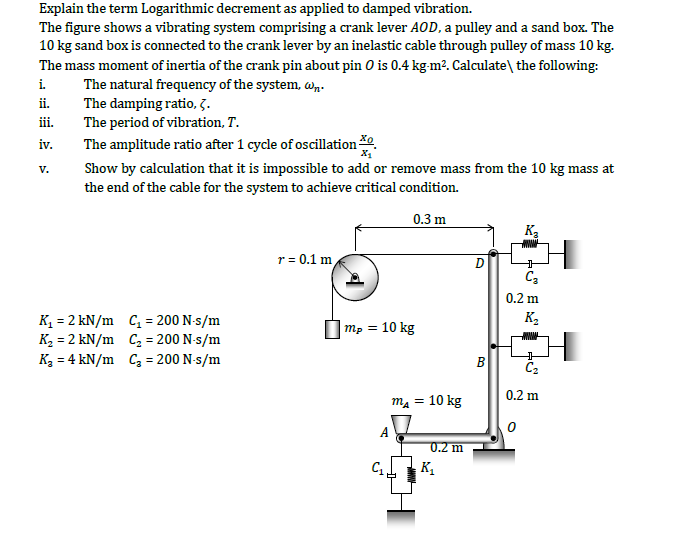Home /
Expert Answers /
Mechanical Engineering /
explain-the-term-logarithmic-decrement-as-applied-to-damped-vibration-the-figure-shows-a-vibratin-pa297
(Solved): Explain the term Logarithmic decrement as applied to damped vibration. The figure shows a vibratin ...
Explain the term Logarithmic decrement as applied to damped vibration. The figure shows a vibrating system comprising a crank lever \( A O D \), a pulley and a sand box. The \( 10 \mathrm{~kg} \) sand box is connected to the crank lever by an inelastic cable through pulley of mass \( 10 \mathrm{~kg} \). The mass moment of inertia of the crank pin about pin \( O \) is \( 0.4 \mathrm{~kg} \cdot \mathrm{m}^{2} \). Calculate \( \backslash \) the following: i. The natural frequency of the system, \( \omega_{n} \). ii. The damping ratio, \( \zeta \). iii. The period of vibration, \( T \). iv. The amplitude ratio after 1 cycle of oscillation \( \frac{X_{0}}{x_{1}} \). v. Show by calculation that it is impossible to add or remove mass from the \( 10 \mathrm{~kg} \) mass at the end of the cable for the system to achieve critical condition. \[ \begin{array}{ll} K_{1}=2 \mathrm{kN} / \mathrm{m} & C_{1}=200 \mathrm{~N} \cdot \mathrm{s} / \mathrm{m} \\ K_{2}=2 \mathrm{kN} / \mathrm{m} & C_{2}=200 \mathrm{~N} \cdot \mathrm{s} / \mathrm{m} \\ K_{3}=4 \mathrm{kN} / \mathrm{m} & C_{3}=200 \mathrm{~N} \cdot \mathrm{s} / \mathrm{m} \end{array} \]
Expert Answer
Answer= Logarithmic decrement is a measure of the damping in a vibrating system. It is defined as the ratio of the amplitude of vibration at two succe
